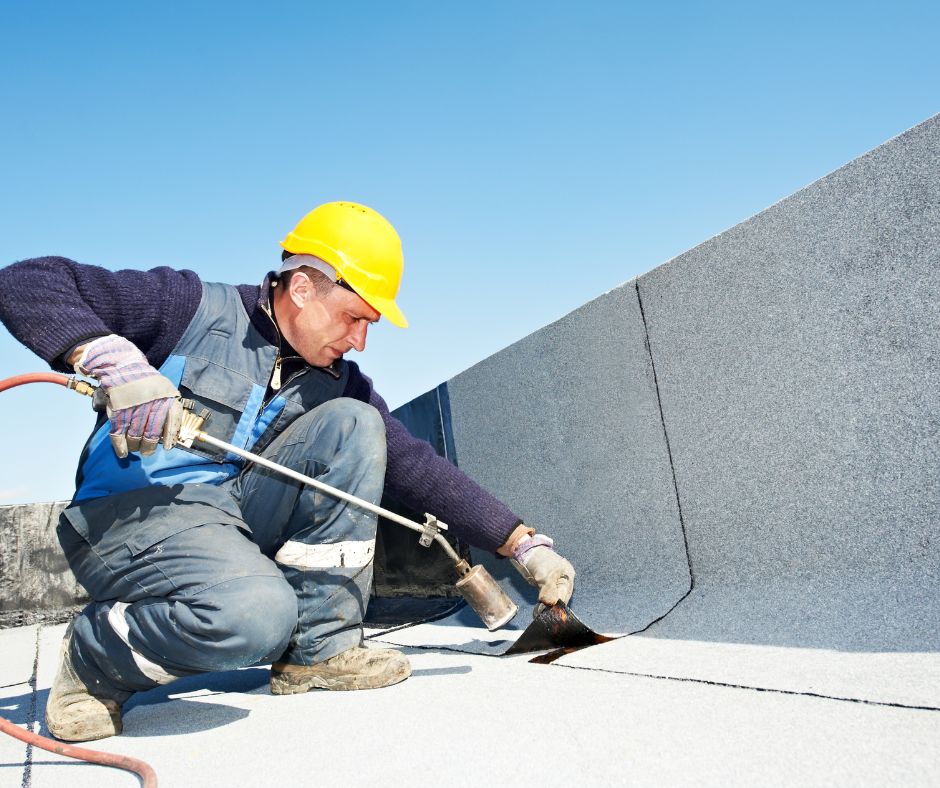We’re here to tell you all about built-up roofing (BUR). With its multiple layers of asphalt and reinforced fabric, BUR offers excellent protection and durability for your roof.
In this article, we’ll explore BUR’s composition, advantages, installation process, and maintenance.
As certified roofers in Athens, GA, we will also compare BUR to other roofing systems so you can make an informed decision. Get ready to learn everything you need about this reliable, long-lasting roofing option.
Let’s dive in!
Composition of Built-Up Roofing
In the composition of built-up roofing, we use layers of bitumen, felt, and gravel to create a durable and weather-resistant surface.
Built-up roofing has a long history, dating back to the 1800s when it was first used in Europe. It became popular in the United States in the early 20th century and has been widely used ever since.
Multiple layers of bitumen felt and gravel are applied, forming a robust and thick roof capable of withstanding severe weather conditions. One of the advantages of built-up roofing is its cost-effectiveness.
Although the initial installation cost may exceed that of alternative roofing materials, the extended lifespan and minimal maintenance needs render it a cost-effective choice over the long term.
Advantages of Built-Up Roofing
Moving on to the advantages of built-up roofing, one of the critical benefits of this roofing system is its durability and weather resistance.
Built-up roofing is renowned for its capacity to endure challenging weather conditions, encompassing heavy rainfall, strong winds, and even hailstorms.
This makes it a reliable choice for buildings in areas prone to severe weather. Another advantage of built-up roofing is its cost-effectiveness.
Despite the potentially higher initial installation cost compared to other roofing systems, the extended lifespan of built-up roofing renders it a cost-effective choice in the long term.
When comparing the lifespan of built-up roofing to other roofing options, it often exceeds them significantly. This makes built-up roofing a wise investment for building owners looking for a durable and cost-effective roofing solution.
Installation Process of Built-Up Roofing
We typically start the installation process of built-up roofing by preparing the roof surface. This process includes clearing the area and eliminating any debris or old roofing materials.
Next, we apply a base layer of asphalt or coal tar to the roof surface, which acts as a waterproofing agent.
Above this foundational layer, we apply numerous layers of roofing felt, along with hot asphalt or coal tar. Each layer is carefully applied and compacted to create a solid, durable roofing system.
Finally, we use a top layer of gravel or mineral granules, which provides protection against UV rays and adds aesthetic appeal.
The installation process of built-up roofing can be time-consuming and labor-intensive, but the end result is a long-lasting and cost-effective roofing solution.
It is important to note that while built-up roofing has many advantages, it has its common problems.
These can include leaks, blistering, and cracking. Appropriate installation and routine maintenance can assist in alleviating these issues and extending the lifespan of the roof.
Maintenance and Repair of Built-Up Roofing
To effectively maintain and repair built-up roofing, regular inspections are essential. Here are some maintenance tips to keep in mind:
– Clear debris: Remove leaves, branches, and other debris regularly to prevent clogging of drains and gutters.
– Check for leaks: Inspect the roof for any signs of leaks, such as water stains or damp areas on the ceiling.
– Address ponding water: Built-up roofing is prone to ponding water, which can lead to damage. Ensure proper drainage to avoid this issue.
Common issues that may require repair include:
– Blistering: Blisters can occur due to trapped moisture or improper installation. Repair by cutting out the blister and applying new roofing material.
– Cracking: Extreme weather conditions can cause cracks in the roofing system. Promptly seal these cracks to prevent further damage.
Regular maintenance and timely repairs will prolong the lifespan of your built-up roofing and ensure its optimal performance.
